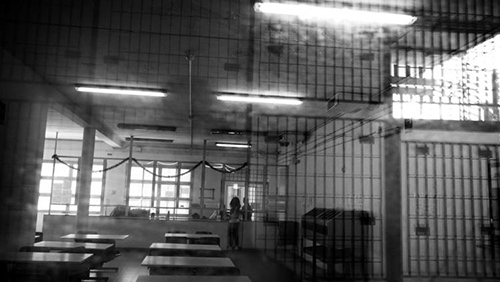Immigration Detention in Italy: Between Security and Humanity

Despite the increasing scholarly attention to immigration detention around the globe, relatively little is known about life and the lived experiences of the people inside these sites of confinement. This is particularly true of the perspectives of professionals who provide services in these contexts. What are the lived experiences of people working in Rome’s detention center of Ponte Galeria? What complexities, struggles and contradictions do they encounter when working inside a custodial environment?
In Italy, the system of immigration detention was set up in the 1990s, when the first detention centers were opened in response to the so called « Albanian emergency », also depicted as an « invasion ». Since its inception, a specific feature of immigration detention in Italy has been the outsourcing of management and service provision to private entities, usually humanitarian agencies (such as social cooperatives) and, more recently, to private multinational companies. Consistent with the government’s effort to humanize detention, any official reference to the concept of “detention” has been avoided. The euphemism “trattenimento” (literally “withholding”) has been used instead to refer to the confinement of legally produced non-citizens.
Female dining hall of Ponte Galeria (Photo: Mario Badagliacca)
Coming from a humanitarian background, staff members seek to offer “assistance” and “help” to detainees. These values and aspirations, however, come into conflict with the repressive nature of the detention system itself. As a result, misunderstandings about the professional mandate of staff members as well as the ambit in which they are called to operate frequently occur. In their accounts, for instance, humanitarian staff members usually refer to detainees as “guests”. They describe Ponte Galeria as a place where migrants can find “humane assistance” while awaiting a decision on their cases. “It is not a prison,” they point out, at times even referring to it as a “reception center”. Even when detention is acknowledged as a form of imprisonment, staff members depict their professional role as standing “shoulder to shoulder” with detainees and guaranteeing their fundamental rights.
Detainees, however, see the role of staff differently. For many, these staff members are simply their “jailers”. They blame them for their detention, and even if they understand their distinction from the police, they are often mistrustful and skeptical about their intentions. In short, detainees question the humanitarian value of staff’s work.
Still, emotions such as sympathy and compassion are able to bloom in a detention setting, even when least expected. The emotional connection that staff members at times establish with detainees, relying on the acknowledgment of a common humanity and vulnerability, has the potential to challenge the climate of mistrust and suspicious on which the detention system rests, as well as the divisions it seeks to draw. Therefore, Ponte Galeria can be seen as a place “where fear and contempt are rife, but where empathy is never wholly effaced”.
External service providers, namely, human right advocates, volunteers of faith-based organizations and religious congregations, lawyers, and journalists, also have to navigate tensions, challenges, and dilemmas in carrying out their work in detention. Whilst, in general, they do not perceive detention in a positive way, and – in some cases – they even manifest an overtly abolitionist position, they choose to carry out their professional activities inside these institutions. In doing so, they work both to provide individual support to detainees (moral, legal and psychosocial aid), and to change the system and its rules. Understanding their mission to be a political one is what actually drives them to keep offering their services in such a coercive site in spite of the numerous challenges they have to face (restrictions concerning access to the center and detainees, lack of information and collaboration on the part of police and, at times, of the managing body). Many of them, especially human rights advocates, are critical of their presence in detention, expressing concerns about their indirect “complicity” with the operation of the detention system. These concerns are also echoed by anti-detention activists, some of whom regard their choice of “entering inside” as having the de facto effect of legitimizing the detention institution.
Such tensions have implications for the relationship that these independent professionals develop with detainees. Due to their limited time and resources, they are only able to provide support that benefits a small number of people incarcerated in Ponte Galeria. Therefore, they are constantly confronted with the uneasy task of deciding whom to help or not. Whereas not responding to detainees’ needs causes professionals stress and frustration, the opportunity to “save” someone from deportation and to help them be released and start a life in Italy, is what provides them with the energy and motivation to continue their work. In many cases, their relationship with detainees continues outside the gates of Ponte Galeria, and at times even develops into friendships.
Especially with regards to refugee camps and reception centers for asylum seekers, an increasing intersection between control and assistance characterizes the enforcement of migration policies. The Italian case, where immigration detention centers have been officially described as “places to provide assistance to migrants while in the process of being deported”, while entrusting their management to private entities with a humanitarian background, is emblematic in this regard. In particular, it is indicative of how a humanitarian discourse has been used to mask the fragmentations, power inequalities, and colonial legacies on which contemporary practices of border control, such as immigration detention, are grounded in Italy.
When analyzing this model of humanitarian government, one, at the same time, should always remember that inside these institutions there are people, detainees as well as professionals. People who have aspirations, desires, values, goals and emotions. They are the ones who experience the material effects of the detention regime, while also being part of its reproduction. As such, understanding their experiences, in their complexities and contradictions, is important in getting the full grasp of how the regime works.
Francesca Esposito
Doctoral Candidate, ISPA-University Institute, Lisbon, Portugal
Silvia Scirocchi
Masters’ degree in Clinical Psychology from Sapienza, University of Rome
This is a shortened version of a post of Border Criminologies’ themed series on “Exploring the Everyday of Immigration Detention” organized by Annika Lindberg, University of Bern, and Laura Rezzonico, University of Neuchatel and nccr – on the move. It was originally published on 1 December 2017. The series brings together insights on the everyday of immigration detention, which has become a normalized part of the deportation regime and is one of many instruments used by states to discipline, control and deport “undesirable” migrants from their territory.



